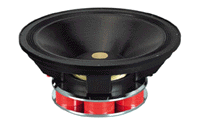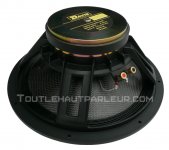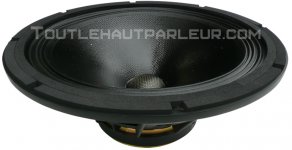If you look at the physics of a simple spring-and-weight resonant system, the resonant frequency varies inversely with the square root of the mass. Double the mass, reduce the frequency to .707 times original, et cetera.
Simple Harmonic Motion
One could fairly easily do that with a speaker. Clearly it would need more power to control the added mass. Would it run out of excursion sooner? I am almost certain this is a bad idea, but I'm not sure why, so I figured I'd ask.
On a related note, with an isobaric pair of speakers, is the vibrating weight two speakers plus a column of air? If so, is that enough to affect resonance significantly?
Simple Harmonic Motion
One could fairly easily do that with a speaker. Clearly it would need more power to control the added mass. Would it run out of excursion sooner? I am almost certain this is a bad idea, but I'm not sure why, so I figured I'd ask.
On a related note, with an isobaric pair of speakers, is the vibrating weight two speakers plus a column of air? If so, is that enough to affect resonance significantly?
If you look at the physics of a simple spring-and-weight resonant system, the resonant frequency varies inversely with the square root of the mass. Double the mass, reduce the frequency to .707 times original, et cetera.
Simple Harmonic Motion
One could fairly easily do that with a speaker. Clearly it would need more power to control the added mass. Would it run out of excursion sooner? I am almost certain this is a bad idea, but I'm not sure why, so I figured I'd ask.
On a related note, with an isobaric pair of speakers, is the vibrating weight two speakers plus a column of air? If so, is that enough to affect resonance significantly?
Follow brand do this - so I think:
:: Ground Zero :: Subwoofer / GZPW 18SPL
http://www.ground-zero-audio.com/13_download/manuals/manual_gzpwspl.pdf
http://www.ground-zero-audio.com/13_download/gzpw.pdf
however, there are the highest requirements in terms of mechanical processing and bonding of diaphragm/surround/viocecoil as well as the max. possible input power.
By car hifi woofers such constructions often to find (MTX, JL-Audio, Earthquake, Bumperspeakers and many more).
Last edited:
Efficiency would drop.
It's also difficult to add weight to the cone, when you have to...
- keep it looking reasonable
- keep the mass central
I tried this method. You need more motor power to properly control the cone - so you'll have to modify the motor structure. Generally speaking, all the other parameters will end up out.
Chris
It's also difficult to add weight to the cone, when you have to...
- keep it looking reasonable
- keep the mass central
I tried this method. You need more motor power to properly control the cone - so you'll have to modify the motor structure. Generally speaking, all the other parameters will end up out.
Chris
A ring of big plumbing solder around the dust cap, potted in black RTV works. As said above, the efficiency gets bad in a hurry and the driver manufacturer usually had things pretty well optimized to begin with. Never really solved a problem this way.
CH
Yes, indeed no great efficiency - have a look to follow datasheet:
:: Ground Zero :: Subwoofer / GZPW* 12SPL
http://www.ground-zero-audio.com/13_download/manuals/manual_gzpwspl.pdf
Impedance: 2x 1 ohm (for 2 ohm or 0,5 ohm impedance)
SPL 2.83 V/m at 2 ohms (4 W): 92 dB; that means SPL1W/m: 86db (122 db/m/4KW) or
SPL 2.83 V/m at 0,5 ohms (16 W): 92 dB; that means SPL1W/m: 80db (116db/m/4KW)
power handling: 6500 W
Advantage: low VAS value and thus only very small enclosure (chamber) necessary
Disadvantage: even by very high output power limiting acoustical output power. Transducer very expensive. Vented box with undistorted sound only with passive radiator. In other cases only closed box possible.
Recommended only in special cases with very very little available space.
If you want to have the other extreme, i. e. very low mass by low resonance frequency "fo" at the same time, efficiency is very good. There are now very high values of VAS and thus the needed chamber is very large. This is my favorite design (see photos from my website), because I can design a vented loudspeaker design without any unwanted effects.
The best example therefore was the Focal Audiom 15AX unfortunately obsolete:
# X-max +/- 2,5 mm
# power handling: 175 Watt
# Impedance: 8 Ohm
# fo: 23 Hz
# Qts=0,31
# Vas=635 liters
# RDC=6,1 Ohm
# 96 dB (1W; 1m)
http://www.falcon-acoustics.co.uk/Units/Audiom15AX.pdf
An nearliest replacement are the 40RCA15 from Davis
Davis Acoustics - Haut-Parleurs
Attachments
Last edited:
Indeed, Vas as well as Qts will both increase & as you pointed out, the efficiency will dropEfficiency would drop.
I tried this method. You need more motor power to properly control the cone - so you'll have to modify the motor structure. Generally speaking, all the other parameters will end up out.
Chris
With the isobaric speakers Fs (free air resonance) will stay the same & so will driver Qts, however the Vas will be halved so a box of half the volume can be used. You don't get something for nothing though as driving both coils will need double the power output..
If you want to go lower in a sealed box i'd suggest keeping the driver the same & employ a Linkwitz Riley transform to force the driver to go deeper
Actually you should get more output.......below 30-40hz
And thats what a sub is about, isnt it
And with lowered Fs it also goes lower, thus greater Xmax is needed
But you can use coating to make an ordinary woofer to go lower
The loss in sensitivity will be at higher frequency, where sensitivity isnt needed anyway
Cleaner sound, and slightly more low bass output....lower Fs and higher Qts
Whether you want to mess with expencive drivers in that way is another concern
In these modern times some kind of Eq appears to be the obvious choise, yes
Coating a midrange driver is a totally different game tho
Anyway, you have to look at compliance stiffness in relation to weight
I dont know why there isnt a commonly specced compliance to weight ratio found anywhere
Ofcourse a woofer with relatively low Fs yet still having a lighter cone will be more "responsive" to mass(mms) changes
And thats what a sub is about, isnt it
And with lowered Fs it also goes lower, thus greater Xmax is needed
But you can use coating to make an ordinary woofer to go lower
The loss in sensitivity will be at higher frequency, where sensitivity isnt needed anyway
Cleaner sound, and slightly more low bass output....lower Fs and higher Qts
Whether you want to mess with expencive drivers in that way is another concern
In these modern times some kind of Eq appears to be the obvious choise, yes
Coating a midrange driver is a totally different game tho
Anyway, you have to look at compliance stiffness in relation to weight
I dont know why there isnt a commonly specced compliance to weight ratio found anywhere
Ofcourse a woofer with relatively low Fs yet still having a lighter cone will be more "responsive" to mass(mms) changes
Adding mass to a driver with very low Q and high fs can
result in a more attractive BR alignment.
The question is whether the driver is able to perform
the larger excursion needed for lower frequencies ...
A typical "high fs / low Qts" driver is often not built for
large excursion.
What happens to the driver:
Qts rises
fs lowers
Vas stays the same (there was a wrong post before ...)
For a BR enclosure the tuning ratio for comparable alignment
h=fb/fs is lower for the mass added driver.
also alpha=Vas/Vab is lower for comparable alignment
which means box volume to increase relative to equivalent volume
of the speakers suspension and cone area when mass is added
to the driver.
Concerning equalizing:
An equalizer cannot be used to influence the lower frequency limit
far below fb (tuning frequency of the BR box).
The amounts of eq needed in the rolloff range of a BR Box will
lead to excessive cone excursion and little effect.
So not everything, which can be done by adding mass and lower
BR tuning can also be done using an equalizer.
Anyway if the Qts gets higher than 0.4 ... 0.5 by adding mass,
i doubt this making sense for BR, since cabinet size increases
very fast then and the alignments possible with those high
Qts drivers are of questionable use.
Best Regards
result in a more attractive BR alignment.
The question is whether the driver is able to perform
the larger excursion needed for lower frequencies ...
A typical "high fs / low Qts" driver is often not built for
large excursion.
What happens to the driver:
Qts rises
fs lowers
Vas stays the same (there was a wrong post before ...)
For a BR enclosure the tuning ratio for comparable alignment
h=fb/fs is lower for the mass added driver.
also alpha=Vas/Vab is lower for comparable alignment
which means box volume to increase relative to equivalent volume
of the speakers suspension and cone area when mass is added
to the driver.
Concerning equalizing:
An equalizer cannot be used to influence the lower frequency limit
far below fb (tuning frequency of the BR box).
The amounts of eq needed in the rolloff range of a BR Box will
lead to excessive cone excursion and little effect.
So not everything, which can be done by adding mass and lower
BR tuning can also be done using an equalizer.
Anyway if the Qts gets higher than 0.4 ... 0.5 by adding mass,
i doubt this making sense for BR, since cabinet size increases
very fast then and the alignments possible with those high
Qts drivers are of questionable use.
Best Regards
Last edited:
Adding mass is easy, what I find difficult is finding and the working out; the math for the effect you want.
By that I mean; is there a simple method to calculate the effect on Fs that a certain mass will have??
I ask because I have a pair of woofers here that I MAY want to modify to increase the Qts to allow its use in a sealed box
By that I mean; is there a simple method to calculate the effect on Fs that a certain mass will have??
I ask because I have a pair of woofers here that I MAY want to modify to increase the Qts to allow its use in a sealed box
A ring of big plumbing solder around the dust cap, potted in black RTV works. As said above, the efficiency gets bad in a hurry and the driver manufacturer usually had things pretty well optimized to begin with. Never really solved a problem this way.
CH
The 'Smaller Advent' speaker from the early '70s used a mass loaded woofer to get the same system resonance as the original Advent - 38 Hz. The efficiency dropped so they changed it to 4 ohms from 8 to increase the power input. It worked reasonably well and at the time there was little else in that size that could get the lows of the Smaller Advent.
I used a similar trick with an 8" subwoofer driver in the back of my car back in '85 to tune the system to 38 Hz and added a low frequency active filter to boost down to 15 Hz and could get reasonable low end from a 32' organ pipe. No, I couldn't get the insane levels the modern car stereo can but mine wasn't just one pitch like I hear going down the street. It was quite musical.
G²
"is there a simple method to calculate the effect on Fs that a certain mass will have??"Fs,
Yes.
Fs, Qe, Qm all change by sqrt of the ratio by which you change mass, and efficiency by the square.
If you double mass, Fs goes down by 1.414X, Qe and Qm increase by 1.414X, and reference efficiency goes down by 6 dB.
Yes.
Fs, Qe, Qm all change by sqrt of the ratio by which you change mass, and efficiency by the square.
If you double mass, Fs goes down by 1.414X, Qe and Qm increase by 1.414X, and reference efficiency goes down by 6 dB.
I recall, that I have see some times ago a bass driver, where I can add and remove wights for variation the mass. Unfortunately I haven't forget brand and model number; this chassis was made especially for the aim of evaluation. Also a passive radiator (same type without magnet) was available from this brand (perhaps Audiotechnology ??).
Last edited:
"is there a simple method to calculate the effect on Fs that a certain mass will have??"Fs,
Yes.
Fs, Qe, Qm all change by sqrt of the ratio by which you change mass, and efficiency by the square.
If you double mass, Fs goes down by 1.414X, Qe and Qm increase by 1.414X, and reference efficiency goes down by 6 dB.
Thanx for that, this needs to go into the wiki if it isn't there already.
I had been given those before but maths and I are somewhat incompatible and I lost the notes when my system crashed last.
Thanx again
Kicker's "Solobaric" subs were basically just mass-loaded so they'd fit in smaller boxes.
Bag End pragmatically takes the opposite approach: they use drivers with a high resonance, and equalize them flat, with processors which prevent amp or driver damage. This allows relatively high efficiency at the kick-drum frequencies, and provides deep bass response to 8 Hz on paper, at inaudible levels unless you invest in a truckload of subs. Which sort of defeats the purpose.
Bag End pragmatically takes the opposite approach: they use drivers with a high resonance, and equalize them flat, with processors which prevent amp or driver damage. This allows relatively high efficiency at the kick-drum frequencies, and provides deep bass response to 8 Hz on paper, at inaudible levels unless you invest in a truckload of subs. Which sort of defeats the purpose.
I recall, that I have see some times ago a bass driver, where I can add and remove wights for variation the mass. Unfortunately I haven't forget brand and model number; this chassis was made especially for the aim of evaluation. Also a passive radiator (same type without magnet) was available from this brand (perhaps Audiotechnology ??).
This both passive radiator cones are equipped with a screw to which you can easily put on and fix the added mass:
http://www.seas.no/images/stories/prestige/pdfdatasheet/h9945_sp22r_datasheet.pdf
830548 - Peerless XLS12 passive radiator 425gr - EUROPE AUDIO
and some other URLs:
Peerless XLS10 10" Subwoofer (830452) and Passive Radiator (830481)
Lungster.Com - Shiva/PR15 sub
But there are also at least one bass transducer brand with same basic principle by their active bass drivers (i. e. passive radiator + magnet + voice coil).
You're welcome.
To be consistent I should have said 2X more mass gives 4X less efficiency, which is 6 dB.
To be consistent I should have said 2X more mass gives 4X less efficiency, which is 6 dB.
Thanx for that, this needs to go into the wiki if it isn't there already.
I had been given those before but maths and I are somewhat incompatible and I lost the notes when my system crashed last.
Thanx again
If I get an extra half octave of extension I'm willing to trade the 6dB, I'll then run them as .5 woofers to the rear.
Just didn't want to experiment on expensive ( relatively ) woofers, looks like I have to add about 90 grams to each of the woofers, that's only a couple of teaspoons of SS powder to a teaspoon or 3 of epoxy
Just didn't want to experiment on expensive ( relatively ) woofers, looks like I have to add about 90 grams to each of the woofers, that's only a couple of teaspoons of SS powder to a teaspoon or 3 of epoxy
- Status
- This old topic is closed. If you want to reopen this topic, contact a moderator using the "Report Post" button.
- Home
- Loudspeakers
- Subwoofers
- Why not just increase mass?


